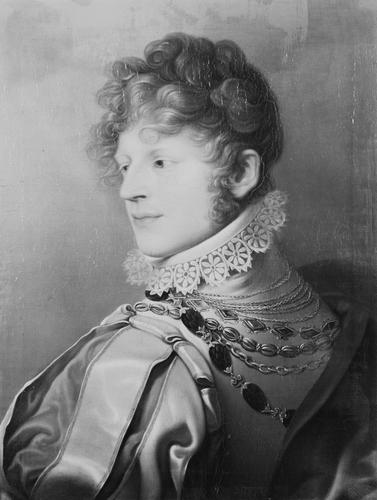Augustus, Duke of Saxe-Gotha-Altenburg (1772-1822) c.1804
Oil on canvas | 64.6 x 50.0 cm (support, canvas/panel/stretcher external) | RCIN 406411
-
Joseph Grassi (1758-1838) began studying at the Academy in Vienna in 1768. He soon began to move in aristocratic circles where he became a favoured portrait painter, particularly of women, whom he painted in oils and in miniature. He style was heavily influenced by English portraiture, for example of Reynolds and Gainsborough, which he became familiar with through engravings and mezzotints. After 1783 he moved to Warsaw where he again gained a reputation as a fashionable portrait painter. In 1800 he was appointed Professor of Fine Arts in Dresden, where he remained for most of his life. In 1804 he spent a sabbatical year in Gotha at the invitation of the sitter for this portrait, Augustus (Emil Leopold August), Duke of Saxe-Gotha-Altenburg (1772-1822), for whom he executed seven paintings illustrating scenes from fables written by the Duke. In Gotha he also undertook numerous commissions including allegorical and more intimate portraits. After a period in Rome between 1816 and 1820, he returned to Dresden where he died in 1838.
Augustus, Duke of Saxe-Gotha-Altenburg, was the second son of Ernst II, Duke of Saxe-Gotha-Altenburg and Princess Charlotte of Saxe-Meiningen. He was the author of a poetic novel, Cyllenion: A year in Arcadia, which is thought to include the first unprejudiced treatment of the theme of homosexual love since antiquity. He was the maternal grandfather of Prince Albert. A version of this portrait, in which the Duke is shown wearing the same lace collar, but not the elaborate costume, may well have been executed during 1804. The Royal Collection has another portrait of the Duke, copied after Grass by Ludwig Döll, in which the head is very similarly posed, but the shoulders are turned to the front (RCIN 407166). The sitter appears here head and shoulders, wearing a Renaissance-style costume with a cream doublet slashed at the sleeves to reveal a blue undershirt, and a high lace collar.
Provenance
First recorded in the stores at Windsor Castle in 1878
-
Creator(s)
(nationality) -
Medium and techniques
Oil on canvas
Measurements
64.6 x 50.0 cm (support, canvas/panel/stretcher external)
85.5 x 71.0 x 6.0 cm (frame, external)
Category
Object type(s)
Alternative title(s)
August, Duke of Saxe-Gotha-Altenburg (1772-1822)
Ernest I, Duke of Saxe-Coburg-Gotha, previously identified as
Ernst I, Duke of Saxe-Coburg-Gotha, previously identified as








